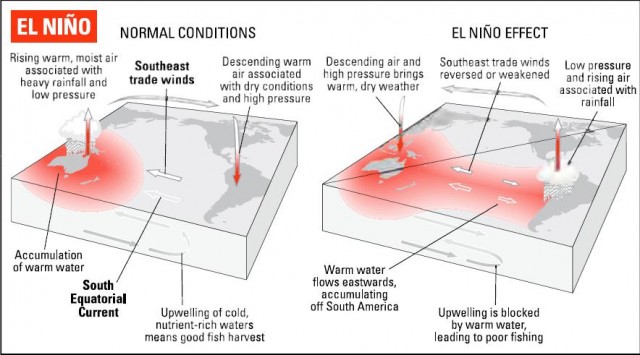Nino or Nina?
El Nino has hit the headlines as a codeword for bad weather, especially in the Pacific and California. But there is a little more to it than that.
The name El Nino might suggest a relatively benign phenomenon. Would the devout Catholics of Latin America call something after the Baby Jesus if it was particularly evil? However, although the phenomenon is usually observed around Christmas time – hence the name – it is a less welcome arrival. The term was first used by fishermen to describe a warm sea current running up the Pacific coast of South America and Mexico at this time of year. It happens when the easterly winds that usually drive water across the south Pacific weaken and allow warmer water to intrude. El Ninos tend to occur every three to seven years.
La Nina is the opposite effect and happens when colder-than-usual water takes over the eastern Pacific. It is about half as frequent as El Nino, and less damaging.

Although El Nino is a warm current that heats the land, it is unwelcome because the water it carries is poor in nutrients. Without the easterly winds, there is no force to drag nutrient-rich water from depth to feed the fish on which local economies depend. But the real importance of El Nino has only become apparent in recent years. It runs far beyond the fish markets of Peru. El Nino is associated with higher-than-usual rainfall in the southern US. In
1997-98, an especially severe El Nino brought fatal flash floods to California. By contrast. La Nina years are dry in the southern US but wetter to the north.
However, El Nino also affects societies which are in less robust condition to fight back. For example, it is associated with droughts in Indonesia, caused by the absence of the cross-Pacific wind that should bring the rain clouds. Droughts associated with El Nino have also been observed in Australia, the Philippines, Brazil and southern Africa. The weather system affected is called the Southern Oscillation, and the whole combination of effects is called ENSO for El Nino/Southern Oscillation.
One topic on which there is no agreement is whether global warming might make El Nino worse in the future. Some computer models think it will; some say it will make future El Ninos less intense; some say the difference will be slight. But by making bad weather more news-worthy, global warming has certainly made El Nino more famous.